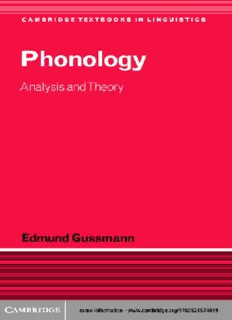
Phonology: Analysis and Theory PDF
Preview Phonology: Analysis and Theory
This page intentionally left blank Clearandconcise,thistextbookisanintroductiontophonologyforstudentswhich assumesnopriorknowledgeofthisareaoflinguisticsandprovidesanoverallview ofthefieldwhichcanbecoveredwithinoneyear.Thebookdoesnotconfineitself toanyspecifictheoreticalapproachandcanthereforebeusedforstudywithinany frameworkandalsotopreparestudentsforworkinmorespecialisedframeworks suchasOptimalityTheory,Government,DependencyandDeclarativePhonology. Eachchapterfocusesonaparticularsetoftheoreticalissuesincludingsegments, syllables,feetandphonologicalprocessing.Gussmannexplorestheseareasusing data drawn from a variety of languages including English, Icelandic, Russian, Irish,Finnish,Turkishandothers.Suggestionsforfurtherreadingandsummaries at the end of each chapter enable students to find their way to more advanced phonologicalwork. EDMUND GUSSMANN isProfessorofGeneralLinguisticsattheUniversityof Gdan´sk,Poland.HisbooksincludeIntroductiontoPhonologicalAnalysis(1980), StudiesinAbstractPhonology(1980),Phono-Morphology(ed.,1985),Licensing inSyntaxandPhonology(ed.,1995)and(withA.Doyle)ReverseDictionaryof ModernIrish(1996). Phonology Analysis and Theory EDMUND GUSSMANN UniversityofGdan´sk Cambridge, New York, Melbourne, Madrid, Cape Town, Singapore, São Paulo Cambridge University Press The Edinburgh Building, Cambridge , United Kingdom Published in the United States of America by Cambridge University Press, New York www.cambridge.org Information on this title: www.cambridge.org/9780521574099 © Edmund Gussmann 2002 This book is in copyright. Subject to statutory exception and to the provision of relevant collective licensing agreements, no reproduction of any part may take place without the written permission of Cambridge University Press. First published in print format 2002 - ---- eBook (EBL) - --- eBook (EBL) - ---- hardback - --- hardback - ---- paperback - --- paperback Cambridge University Press has no responsibility for the persistence or accuracy of s for external or third-party internet websites referred to in this book, and does not guarantee that any content on such websites is, or will remain, accurate or appropriate. Contents Preface pageix Listofabbreviations xiii 1 Soundsandsegments 1 1.1 Introduction 1 1.2 AspirationofplosivesinEnglish 4 1.3 TheMuskerryIrish[ɑ–a]alternation 7 1.4 DarkandclearlinRPEnglish 11 1.5 VoicednessoffricativesinOldandModernEnglish 12 1.6 Summary 16 1.7 Suggestedfurtherreading 17 2 Themelodyandtheskeleton 19 2.1 Introduction 19 2.2 EquivalenceoflongvowelsanddiphthongsinEnglish 20 2.3 GermanicandFinnishnuclearsimplifications 23 2.4 CompensatorylengtheninginGermanicandTurkish 28 2.5 ThephonologyofEnglishinflectionalmorphology 31 2.6 Englishlinkingrandtheunassociatedmelody 40 2.7 Summary 43 2.8 Suggestedfurtherreading 44 3 Domainsandphonologicalregularities 45 3.1 Introduction 45 3.2 ThevelarnasalconsonantinEnglish 46 3.3 PreaspirationinModernIcelandic 54 3.4 DorsalspirantsinStandardGerman 59 3.5 Summary 63 3.6 Suggestedfurtherreading 64 4 Thesyllable 66 4.1 Introduction 66 4.2 SomesimpleEnglishsyllables 67 v vi Contents 4.3 Emptyonsets:Frenchh-aspire´ 69 4.4 Englishonsetsandrhymes 72 4.5 NasalassimilationornasalplacesharinginEnglish 78 4.6 NasalplacesharinginDutchandGerman 82 4.7 NasalplacesharinginPolish 86 4.8 Summary 89 4.9 Suggestedfurtherreading 90 5 Moreoncodas 91 5.1 Introduction 91 5.2 Word-finalconsonantsinIrish 92 5.3 Englishword-finalconsonantsandinternalcodas 96 5.4 Nasal–obstruentplacesharingcontinued 101 5.5 Consonantsequencesstartingwith[s] 107 5.6 Summary 116 5.7 Suggestedfurtherreading 117 6 Somesegmentalregularities 118 6.1 Introduction 118 6.2 Turkishvowelharmony 119 6.3 VowelreductioninEnglish 124 6.4 Polishnasalvowels 130 6.5 ObstruentsequencesinIcelandic 134 6.6 Russianvowelreduction 139 6.7 Germanfinaldevoicing 145 6.8 Summary 154 6.9 Suggestedfurtherreading 156 7 Syllable structure and phonological effects: quantity inIcelandic 157 7.1 Introduction 157 7.2 Preliminaries 157 7.3 Opensyllablelengthening 159 7.4 Word-finalconsonantsandvowellength 161 7.5 Codas,onsetsandvocalicquantity 163 7.6 Quantityasevidenceforsyllabification 167 7.7 Coda–onsetcontactsinIcelandic 178 7.8 Lengthincompounds 181 7.9 Summary 184 7.10 Suggestedfurtherreading 185 8 Segmentaldoubleagents 186 8.1 Introduction 186 8.2 Icelandicvowellength:anextension 187 Contents vii 8.3 Russianlabialfricatives 193 8.4 Polishdorsalobstruents 197 8.5 Welshvowels 200 8.6 Summary 203 8.7 Suggestedfurtherreading 204 9 Wordsandfeet:stressinMunsterIrish 205 9.1 Introduction 205 9.2 Stressandnuclei 206 9.3 Stressandfeet 214 9.4 Summary 222 9.5 Suggestedfurtherreading 223 Conclusion 224 AppendixThephoneticalphabetoftheInternational PhoneticAssociation 226 References 227 Index 233
Description: